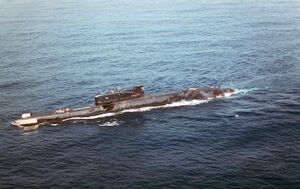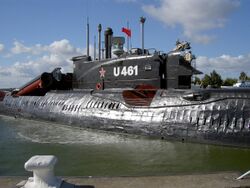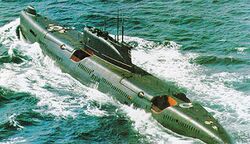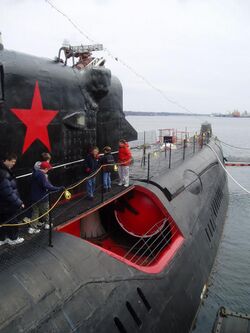Engineering:Juliett-class submarine
 K-77, a Juliett-class submarine
| |
| Class overview | |
|---|---|
| Operators: |
|
| Preceded by: | Echo I class |
| Succeeded by: | Charlie class |
| Subclasses: | 1960–1968 |
| In commission: | 1963–1994 |
| Planned: | 35 |
| Completed: | 16 |
| Cancelled: | 19 |
| Retired: | 16 |
| Preserved: | 1 |
| General characteristics | |
| Type: | Submarine |
| Displacement: | |
| Length: | 85.9 m (281 ft 10 in) |
| Beam: | 9.7 m (31 ft 10 in) |
| Draft: | 3.29 m (10 ft 10 in) |
| Propulsion: |
|
| Speed: |
|
| Range: |
|
| Test depth: | 240 m (790 ft) |
| Complement: | 78 |
| Sensors and processing systems: |
|
| Electronic warfare & decoys: | Nakat-M ESM |
| Armament: |
|
Project 651, known in the West by its NATO reporting name Juliett class, was a class of Soviet diesel-electric submarines armed with cruise missiles. They were designed in the late 1950s to provide the Soviet Navy with a nuclear strike capability against targets along the east coast of the United States and enemy combatants (aircraft carriers). The head of the design team was Abram Samuilovich Kassatsier. They carried four nuclear-capable cruise missiles with a range of approximately 300 nautical miles (560 km), which could be launched while the submarine was surfaced and moving less than four knots (7.4 km/h). Once surfaced, the first missile could be launched in about five minutes; subsequent missiles would follow within about ten seconds each. Initially, the missiles were the inertially-guided P-5 (NATO reporting name SS-N-3c Shaddock). When submarine-launched ballistic missiles rendered the P-5s obsolescent, they were replaced with the P-6 (also NATO reporting name SS-N-3a Shaddock, though a very different missile) designed to attack aircraft carriers. A special 10 m2 target guidance radar was built into the forward edge of the sail structure, which opened by rotating. One boat was eventually fitted with the Kasatka satellite downlink for targeting information to support P-500 4K-80 "Bazalt" (SS-N-12 Sandbox) anti-ship cruise missiles. The Juliett class had a low magnetic signature austenitic steel double hull, covered by two inches (51 mm) thick black tiles made of sound-absorbing hard rubber.
Background and description
In the late 1950s, the Soviet Navy was tasked to neutralize American bases and aircraft carriers. It began construction of a large number of expensive nuclear-powered (Echo-class submarines) to accomplish this, but could not build enough nuclear reactors to equip them promptly. Even though the Juliett class was inferior to the Echos, it was ordered into production because it did not require resources needed for the nuclear boats.[1]
The Juliett-class boats are a double-hulled design that displaces 3,174 metric tons (3,124 long tons) on the surface and 3,750 tonnes (3,690 long tons) submerged. The boats have an overall length of 85.9 meters (281 ft 10 in), a beam of 9.7 meters (31 ft 10 in) and a draft (ship) of 6.29 meters (20 ft 8 in). The Julietts have a test depth of 240 meters (790 ft) and a design depth of 300 meters (980 ft). The prominent blast deflectors cut out of the outer hull behind the missile launchers make the submarines very noisy at high speed. Their crew numbered 78 men.[2]
Propulsion and performance
The Juliett class is powered by a diesel-electric system that consists of two 4,000-metric-horsepower (2,900 kW) 1D43 diesel engines and a pair of 3,000 PS (2,200 kW) MG-141 electric motors for cruising on the surface. Two additional 200 PS (150 kW) electric motors are intended for slow speeds underwater and are powered by four banks of lead-acid battery cells that are recharged by a 1,000 PS (740 kW) 1DL42 diesel generator. The boats are fitted with a retractable snorkel to allow the diesel engines to operate while underwater.[3]
On the surface, the submarines have a maximum speed of 16 knots (30 km/h; 18 mph). Using their diesel-electric system while snorkeling gives the Julietts a range of 18,000 nautical miles (33,000 km; 21,000 mi) at 7 knots (13 km/h; 8.1 mph). Using just the electric motors underwater, they have a maximum range of 810 nmi (1,500 km; 930 mi) at 2.74 knots (5.07 km/h; 3.15 mph). Their best submerged speed on electric motors is 18 knots (33 km/h; 21 mph), although it reduces their range to 27.8 nmi (51.5 km; 32.0 mi). They could carry enough supplies for 90 days of operation.[4][5]
Armament
To carry out the Julietts' mission of destroying American carrier battle groups and bases, they were fitted with two pairs of missile launchers, one each fore and aft of the sail. The launchers were used by the surface-launched SS-N-3 Shaddock family of long-range, turbojet-powered, cruise missiles. The P-5D version was codenamed SS-N-3c by NATO and was a dedicated land-attack missile that could be equipped with either a high-explosive or nuclear warhead; it was withdrawn from service in 1965–1966. The P-6 (SS-N-3a) variant was a radar-guided anti-ship missile that could also be fitted with high-explosive and nuclear warheads.[6]
The more traditional armament of the Julietts consisted of six 533-millimeter (21 in) torpedo tubes mounted in the bow and four 406-millimeter (16 in) torpedo tubes in the stern. Due to space limitations, no reloads were provided for the bow tubes, but each stern tube had two reloads for a total of twelve.[4]
Fire control and sensors

The submarines relied upon aircraft for their long-range anti-ship targeting which they received via the Uspekh-U datalink system. Their own Argument missile-guidance radar (NATO reporting name: Front Door) controlled the P-6 missiles until they were out of range via a datalink codenamed Front Piece. The missiles' onboard radar would detect the targets and transmit an image back to the submarine via video datalink so the crew could select which target to attack, after which the missile relied upon its own radar for terminal guidance. The Argument radar has a massive antenna that was stowed at the front of the sail and rotated 180° for use. The Front Piece antenna was mounted on top of the Argument antenna.[7]
The boats are fitted with Artika-M (MG-200) and Herkules (MG-15) sonars, Feniks-M (MG-10) and MG-13 hydrophones and an Albatros RLK-50 search radar[3] (NATO reporting name: Snoop Tray). They are also equipped with a Nakat-M Electronic warfare support measures system.[8]




Initial plans called for 35 submarines of this class but only 16 were built, two - including the lead sub, by the Baltic Shipyard, St. Petersburg and the rest by the Krasnoye Sormovo Shipyard in Nizhny Novgorod. They were commissioned between 1963 and 1968 and served through the 1980s. The last one was decommissioned in 1994.
The Juliett class was built due to expected delays in the continued production of the nuclear-powered Project 659 Echo I-class submarines and 675 Echo II-class submarines, with six and eight missile launchers, respectively. The Julietts were designed after the Echos.
Units
| Name | Shipyard | Laid down | Launched | Commissioned | Fate |
|---|---|---|---|---|---|
| K-156 | Baltic Shipyard, Leningrad | November 16, 1960 | July 31, 1962 | December 10, 1963 | Decommissioned September 1991 for scrapping[9] |
| K-85 | October 25, 1961 | January 31, 1964 | December 30, 1964 | Decommissioned for scrapping[9] | |
| K-70 | Krasnoye Sormovo Shipyard, Gorky | August 25, 1962 | February 6, 1964 | December 31, 1964 | Decommissioned in 1994 for scrapping[9] |
| K-24 | October 15, 1961 | December 15, 1962 | October 31, 1965 | Decommissioned in 1994, sold to Germany as maritime museum exhibit[9] | |
| K-68 | January 25, 1962 | April 30, 1963 | December 28, 1965 | Decommissioned in 1990 for scrapping[9] | |
| K-77 | January 31, 1963 | March 11, 1965 | October 31, 1965 | Decommissioned in April 1992 and sold as museum exhibit in U.S.[9] Sank after a storm in 2007 and subsequently scrapped.[10] | |
| K-81 | November 20, 1963 | August 7, 1964 | December 14, 1965 | Decommissioned in 1994 for scrapping[9] | |
| K-63 | March 25, 1962 | July 26, 1963 | June 12, 1966 | Decommissioned in September 1991 for scrapping[9] | |
| K-58 | July 15, 1963 | February 2, 1966 | September 23, 1966 | Decommissioned 1990 for scrapping[9] | |
| K-73 | August 1, 1964 | May 31, 1966 | December 15, 1966 | Decommissioned in 1990 for scrapping[9] | |
| K-67 | January 31, 1965 | October 29, 1966 | September 30, 1967 | Decommissioned in 1994 for scrapping[9] | |
| K-78 | July 25, 1965 | March 30, 1967 | November 1, 1967 | Decommissioned in September 1991 for scrapping[9] | |
| K-203 | December 23, 1965 | June 30, 1967 | December 2, 1967 | Decommissioned in September 1992 for scrapping[9] | |
| K-304 | August 6, 1966 | November 24, 1967 | August 21, 1968 | Decommissioned in September 1991 for scrapping[9] | |
| K-318 | March 29, 1967 | March 29, 1968 | September 29, 1968 | Decommissioned in 1994 for scrapping[9] | |
| K-120 | March 25, 1967 | July 11, 1968 | December 26, 1968 | Decommissioned in April 1991 for scrapping[9] |
References
- ↑ Friedman, p. 344; Vilches Alarcón, pp. 13–14
- ↑ Pavlov, p. 60; Vilches Alarcón, p. 13
- ↑ 3.0 3.1 Hampshire, p. 24
- ↑ 4.0 4.1 Pavlov, p. 60
- ↑ Friedman, p. 402
- ↑ Vilches Alarcón, pp. 12, 18, 22; Polmar & Noot, p. 289
- ↑ Polmar & Moore, p. 97; Hampshire, pp. 26–27
- ↑ Hampshire, p. 25
- ↑ 9.00 9.01 9.02 9.03 9.04 9.05 9.06 9.07 9.08 9.09 9.10 9.11 9.12 9.13 9.14 9.15 Korabli VMF SSSR, Vol. 1, Part 2, Yu. Apalkov, Sankt Peterburg, 2003, ISBN:5-8172-0072-4
- ↑ "Juliett 484 - News". http://www.juliett484.org/juliett/news/archive/pressrelease081009.html.
Bibliography
- Friedman, Norman (1995). "Soviet Union 1947–1991: Russian Federation and Successor States 1991–". Conway's All the World's Fighting Ships 1947–1995. Annapolis, Maryland: Naval Institute Press. pp. 337–426. ISBN 1-55750-132-7.
- Hampshire, Edward (2018). Soviet Cruise Missile Submarines of the Cold War. London: Osprey Publishing. ISBN 978-1-47282-499-8.
- Pavlov, A. S. (1997). Warships of the USSR and Russia 1945–1995. Annapolis, Maryland: Naval Institute Press. ISBN 1-55750-671-X.
- Polmar, Norman; Moore, Kenneth J. (2004). Cold War Submarines: The Design and Construction of U.S. and Soviet Submarines. Washington, D. C.: Potomac Books. ISBN 978-1-57488-594-1.
- Polmar, Norman; Noot, Jurrien (1991). Submarines of the Russian and Soviet Navies, 1718–1990. Annapolis, Maryland: Naval Institute Press. ISBN 0-87021-570-1.
- Vilches Alarcón, Alejandro A. (2022). From Juliettes to Yasens: Development and Operational History of Soviet Cruise-Missile Submarines. Europe @ War (22). Warwick, UK: Helion & Co.. ISBN 978-1-915070-68-5.
External links
 |

